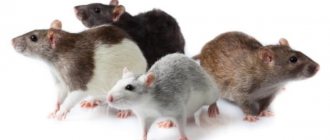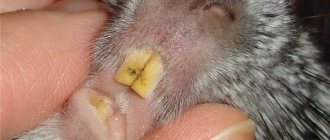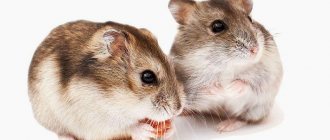Man has long shown concern for his smaller brothers. Recently, it has become fashionable to keep a four-legged friend or a winged pet in your home or apartment. This is exactly what a person cut off from nature lacks. Communication with pets brings a lot of pleasure, and children get involved in caring for them. Pets, in turn, respond to such care by becoming attached to their owner and family members.
Many keep decorative rats, which are considered quite intelligent and affectionate pets. Before you bring this charming rodent into your home, it is better to learn more about these animals, especially in terms of care and maintenance. It is believed that the level of intelligence of this rodent is not inferior to many species of dogs or cats.
Why have a rat at home?
Keeping and caring for a pet rodent does not require any special effort or expenditure of time and money. These small animals are easy to train. Like domestic cats or dogs, they happily greet their owner. They trust their owner completely, as well as the rest of the family, including children.
It should be noted that these animals themselves choose their favorites among the family. Most likely, those who pay the most attention to animals become such favorites. The more often someone picks them up, the faster the animal gets used to it and considers it its owner. At the same time, the animals give all their love and affection, paying tribute to the same love and affection that a person surrounds their pets with.
Is it true that they are marking territory?
Many people say that they leave drops of urine everywhere. This behavior is quite normal; rodents in nature have the right to mark their territory.
The fact is that urine contains a huge amount of information that they leave for their relatives.
They not only mark their territory, but also convey information about age, social status, sexual maturity and stress. Marking territory is more common among men, but women are no exception.
During walks, owners often lay out a special fabric to protect carpets and furniture from such “scented” traces.
Sometimes pets urinate on themselves, but this is not due to markings, it is a sign of illness and you should contact your veterinarian. If you skip the labeling issues, they are usually very clean and easy to get used to in the litter box.
A little history
Cute, affectionate and tame decorative rats are descended from ordinary wild gray rats, which cause a feeling of disgust in humans, as well as a certain fear. This is not at all surprising, since wild rats have gained notoriety not only for their behavior, but also for their ability to spread various viruses and infections.
The Chinese and Indians first became aware of wild rats several thousand years ago. In the 16th century, as maritime trade developed, rats spread throughout the world, moving from continent to continent. In the 19th century in England, these rodents began to be used in battles against dogs, after catching them. During the same period, some hobbyists began breeding rats, especially tame, white ones. Such tame rodents were shown at exhibitions; in addition, white rats took part in circus performances. Some pet lovers started keeping rodents in their homes because they did not pose any danger to humans.
Some of the individuals were used as experimental animals in various laboratories, which is still practiced today, and some of them moved into the homes of scientists. Scientists saw in rats animals that are quite intelligent and attached to humans. Thanks to the crossing of laboratory rats with wild animals, new species and breeds of domestic decorative rodents have appeared, which can still be found among various breeders.
Hygiene and bathing
Rats are clean animals and can take care of themselves on their own. Therefore, they are bathed only if necessary: in the presence of strong dirt, odor, or before participating in an exhibition.
The older the rodent, the more difficult it is for him to care for himself. During this period, hygiene procedures must be carried out by the owner, for example, he must cut the rat’s claws.
They bathe the pet using special products in a calm environment. Animals react differently to water, so the owner should study the individual characteristics of the animal.
First, you can lightly wet the fur, avoiding getting water into the ears, and see how the rat behaves. If the pet is worried, use a small amount of water for bathing.
The following recommendations will help ensure a safe procedure:
- maintaining optimal temperature conditions in the room;
- if the pet resists bathing, water procedures are carried out only if absolutely necessary;
- To avoid damaging the rodent's skin, use a soft sponge.
Rat as a pet: advantages
Many people prefer pet rats as this is an ideal option. Despite the fact that for many people the mere mention of rats causes an ambiguous reaction, when they pick up this cute creature they instantly change their attitude. This is not at all surprising, since decorative and domestic rats are two very different things. As a result of training, these animals are able to master various tricks that make both children and adults admire them.
Caring for a pet is quite simple, since it requires a spacious cage, litter, water and cheap food. If you think of a domestic rat as a dirty and infectious rodent, then this is a huge mistake, since the decorative rodent is considered a very clean animal. If you clean the animal’s cage in a timely manner, then there can be no talk of any smell. The rat itself chooses one of the corners to relieve itself. If for some reason a bowl of food ends up near this place, then the rat drags it with its teeth to a clean place, away from this corner.
This rodent's need for communication is quite high. One should take into account the fact that each animal is an individual, with its own needs and character. It is very important to understand this in time. The domestic rat quickly remembers voices and smells, responding to its name. If you have training skills, you can train your rat to fetch small objects.
This cheerful living creature often plays for hours with children and adults, which lifts the spirits of all family members, forgetting about pressing problems. They feel great in human hands and squeak with pleasure when their belly, back and ears are stroked. These are animals that easily relieve the stress of any person who feels some kind of oppression from work or other everyday worries. Keeping such animals at home gives a person extremely positive emotions, the level of which determines a person’s psycho-emotional state.
Decorative Rat - All about the type of rodent | Type of rodent – Decorative Rat
Rat character
This phrase sounds intimidating and even a little unpleasant. But in reality, the domestic rat (owner reviews indicate this) has an excellent character and a number of advantages that make this rodent a favorite pet in many families.
A rat, as a pet, is not inferior to a cat in terms of cleanliness. She also washes her face frequently. If the cage is cleaned properly and in a timely manner, there will be no unpleasant odor in the house. Keeping a pet rat can be combined with training this animal. Don’t be surprised, but these animals, like dogs, can perform various commands - “stand”, “lie down”, “sit” and others. A treat will help you achieve results.
We can say that rats are omnivores. But in this article we will tell you what you should not feed these rodents. It is very interesting to watch these animals in a well-equipped cage: with a wheel, all kinds of rings and pipes. Rats deftly use their tails and their prehensile paws.
Types of decorative rats with photos
There are several breed types of decorative rats, which people take great pleasure in keeping in their homes, to the delight of their relatives.
Standard
The most common breed of decorative rats, which is the ancestor of other varieties. It is distinguished by a compacted and elongated body, smooth coat, wide ears and a long tail covered with sparse hairs.
Dumbo
It has a cute and unique appearance. Due to the presence of relatively large and protruding ears, the rodent's muzzle has a very funny appearance. The little rat got its name because of these protruding ears, which are very similar to the ears of the eponymous baby elephant Dumbo, invented by Disney directors.
Rex
An equally popular variety of domestic rodent. A characteristic feature of the animal is that this rat has wavy fur. Because of this feature, the animal looks more like a living plush toy.
Sphinx
The breed can truly be considered unique, since the animal has no fur, with the exception of rare hairs covering the upper part of the body. Rodents have folded skin of a pale pink hue, which gives the animal some tenderness, although this breed is more for lovers and not everyone is ready to keep this animal at home. On the other hand, this is an excellent option for those who suffer from allergies.
Satin
This breed is very popular among owners in European countries. It is distinguished by a unique, shiny, satin-like coat. This uniqueness is the determining factor that contributes to the great demand for the animal.
Tailless
This rodent lacks a tail, which is how the rodent got its name. The animal has a pear-shaped body. With all this, these factors do not negatively affect the popularity of this breed.
Types of decorative rats | Pet rats
Types and breeds of rodents
Thanks to the work of breeders, there are many species of ornamental rats. Far in the past are the times when, in addition to gray street rats, people only knew about white laboratory rodents.
Decorative breeds of rats:
- standard - the breed from which other varieties came (the body is dense, elongated, the coat is thick, smooth);
- Dumbo - the name of these rats is due to the fact that they have the largest ears, reminiscent of the Disney baby elephant;
- rex - decorative rats with wavy fur;
- double rex - there are both bald and furred areas on the animal’s body;
- downy - the entire body of the animal is covered with soft down;
- satin - rats with long, shiny fur;
- Sphynx - rodents are almost bald with the exception of small patches of hair on the cheeks, paws and groin area;
- tailless - rats with a pear-shaped body without a tail.
Domestic rodents
On average, the weight of a female ornamental rat is 280–350 g, a male from 500 to 600 g. But these indicators are very relative, as are the sizes of rodents. Due to its special structure, the rat's body can either stretch or shrink, so it is quite difficult to accurately measure the length of the rodent.
Physiological characteristics of the domestic rat
On average, decorative rats live within 2 years, but in conditions of proper maintenance and care - about 4 years. Caring for a rat is so simple that a primary school student can cope with such a task, which contributes to the emergence of two friends for life.
In the wild, rats are nocturnal and rest during the day. When at home, rodents try to adapt to human routines and are more awake during the day than at night.
Description
The domestic decorative rat is a small animal. The male weighs about 600 grams, the female is twice as small - 300 grams. Body length is from 8 to 25 centimeters. The build and shape of the muzzle depend on the breed, but most often they have an elongated nose. The body is covered with fur, the density of which also depends on the breed, the tail is almost bare, up to 18 centimeters long, and the legs are short. The color is often monochromatic - red, white, black, gray.
At the same time, among some breeds there are individuals with two-color coats. The color of the eyes also depends on the color, for example, white rats have pink eyes, gray rats have black eyes.
Group and single keeping of decorative rats
Since rats are social animals, they can be kept either alone or in groups. But this does not mean at all that there will be no problems even with group keeping. At the initial stage, it is better to get one rodent, since keeping several animals involves some nuances. As a rule, in any flock, even a small one, there will be conflicting individuals, so civil strife is guaranteed. If there are fights, then there will be injuries that the owner will have to heal. It is better to place the fighter in a separate cage in a timely manner.
When purchasing an animal, a pet store may advise you to purchase a couple of animals of the same age. They motivate this by the fact that rodents get bored in the absence of their owner. If they are kept in the same cage, then numerous offspring may soon appear or the female will die from early mating.
Being in the natural environment, rats form same-sex packs and animals that have reached sexual maturity mate only for reproduction. In other words, females mate only when they are completely ready for the process. If the owner does not intend to practice breeding these animals, then it is better to have a couple of same-sex animals.
Regardless of whether there is one rat or two, caring for them is no different, you just need to be prepared for the fact that two males will sort things out with each other from time to time. All individuals become equally attached to their owner and can compete for his attention and affection. If the owner and family members are not at home, then the animals play with each other. Therefore, the development of two pets is more optimal and they feel happier and more emotionally stable.
When keeping one animal, you should remember that you will have to devote more time to the animal so that the animal does not feel lonely. Therefore, the owner is simply obliged to take the rodent with him whenever possible, whether at home or going outside. If this is not possible or you don’t really want to do this, it is better to get a couple of same-sex rodents, then they will always have someone to play with.
Keeping a pet
Domestic rats have strong immunity and stamina, but this should not be abused. In order for your pet to be healthy and live a long time, you need to carefully care for it.
Purity
The key to good rodent health is cleanliness . You need to wash the cage daily. The tray must be rinsed and treated with products without an aggressive odor. Remember that rodents have a very keen sense of smell, so “fragrant” cleaning chemicals can harm your pet.
In addition to washing the tray, the cage itself must be cleaned. Once a week, thoroughly wash the rods, houses and all equipment in the rodent’s home. Old food supplies should be thrown away so that microbes do not multiply in them. If your pet is very zealous in collecting provisions, then the entire collected set can be replaced with a piece of carrot. No matter how smart the rat is, it has not yet learned to count.
In addition to cleaning the room , it is recommended to occasionally bathe the rat . Rodents are not afraid of water, so there will be no problems with the procedure. Fill the bath with just enough warm water to touch the tummy of the rat standing in it. Let your pet swim, then pat the fur dry with a towel.
Females should be bathed once a month, while males should be bathed more frequently, once every two weeks.
From the video you will learn how to properly care for your tailed friend.
Feeding
The lifespan of a rodent is also affected by the quality of its diet . Only natural products are suitable for feeding your pet. Rats are omnivores by nature, however, if you want to prolong the life of the animal, then you should not indulge its weaknesses.
Rats have a big sweet tooth. They love everything sweet, sticky, delicious-smelling and even salty. If a mouse has once tasted a candy, then, hearing the familiar rustle of the wrapper, it will turn the cage upside down until you give it the sweetness. To avoid such begging, do not give your rat junk food, even as an experiment.
She should be fed natural food high in carbohydrates. Grain is optimal for this purpose. In addition to being saturated with carbohydrates, the rat will be able to wear down its teeth on the grains, which, by the way, grow throughout its life.
In addition to grain, they can be given:
- boiled vegetables, fruits and other plant foods. Over time, each pet develops personal preferences;
- crackers, unsweetened crackers;
- vitamins and minerals from the pharmacy;
- dairy products;
- boiled meat and poultry.
Do not allow your pet to eat food uncontrollably. The daily norm for an adult rodent is 40 g of food. Physical activity in the form of running and walking is required.
Harmful products should be excluded:
- food with seasonings, as well as salty, spicy and fatty foods;
- sweet products, desserts. Chocolate is especially harmful to rats;
- oranges, lemons and other citrus fruits;
- raw potatoes, carrots and other vegetables;
- raw meat and fish;
- grass growing outside.
Arrangement of the house
The moral well-being of a pet plays an important role in its life expectancy. The pet should be warm, cozy and fun .
It is important to choose a cage in which the rodent will be comfortable. The gap between the twigs should not exceed 1 cm. Remember that if the rat was able to stick its head into the hole, then all of it will fit into it. And he will run away.
Rats love to climb various ladders and shelves. You can purchase a ready-made “cottage”, or equip it at your own discretion. The main thing is to ensure that the materials used to create “furniture” are non-toxic.
Arrangement rules:
- exercise equipment must be securely fastened;
- the tray should be deep so that the animal does not come into contact with its own feces;
- a drinking bowl with clean water is required;
- the bedding can be made of sawdust or paper (without printing ink!);
- a house where the rat can retire: a box, a pot, etc.;
- Animals have their own ideas about cleanliness, so the owner must do the cleaning.
Rats are wonderful pets that are great for both adults and children. In order for the pet to please the owner longer, the rodent’s life needs to be arranged in accordance with all the rules.
Cell selection
In order for your pet to feel great, you need to purchase a spacious cage with a set of all the necessary accessories and balanced food. You should always remember that the cage for a fluffy rat plays a very important role, since he spends most of his life in it. Therefore, when choosing a cage, you should be guided by the following requirements.
Cage dimensions
It is not recommended to keep your pet in a cramped cage, as the animal likes to move a lot. As a rule, the optimal cage dimensions are within the following limits: cage width – 40 cm, cage length – 60 cm and cage height – also 60 cm. For such an animal, this space is absolutely enough. The distance between the cage bars should be no more than 1.2 cm.
bottom of the cage
For such rodents, a solid floor is more suitable, since a lattice floor leads to injuries to the rodents’ limbs.
Cage tray
The starting material for the pallet is durable plastic. The pallet should have high sides to prevent the filler from spilling out. The pallet should not be made of wood, since wood will absorb urine, which will cause an unpleasant odor in the home.
Cage design
The best option is a collapsible cage with large doors to make it convenient to clean, wash, feed and hang various elements. The cage must have shelves for animals to rest.
Cage coating
As a rule, cage rods are coated with enamel, zinc or powder paint, which is not critical. The main thing is that the coating is of high quality, without chips or rust.
Quarantine
Another rule that owners often neglect. And completely in vain. The purchased rat must be isolated from other animals (if they are already living in a cage) for four weeks. She is placed in another house and in another room, since some viruses can sometimes be airborne.
To avoid infecting old pets, after interacting with a new rat, wash your hands with soap and carefully observe the animal to see if it shows signs of disease.
Arrangement of a cage for a decorative rat
A cage for a pet will be very comfortable and cozy if it contains a set of various accessories that provide feeding, odor absorption, play, and relaxation. Therefore, when purchasing a cage, you should immediately purchase elements for its arrangement.
Filler
Basically, rat breeders use corn litter, although it is relatively expensive. It is not recommended to use sawdust as it can cause allergic reactions in rodents. Another option is a filler made from paper napkins or toilet paper. The option is quite cheap, but requires frequent replacement. In this case, you cannot use newspapers and magazines, since your pet can be poisoned by printing ink.
Food bowls
There are hanging bowls that are attached to the bars of the cage. Dry food is poured into them, but for liquid food it is better to purchase heavy ceramic bowls so that the rodent cannot move them.
Drinking bowl
The cage is equipped with a nipple drinker that is safe to use.
Availability of a house
Rodents very often rest, hiding in a small house. The bottom of the house can be covered with a piece of soft material. Such a house can simply be placed at the bottom of the cage or hung up.
Hammock
The pet loves to sleep or just relax in a hammock. It can be hung as high as possible in the cage. You can either buy this accessory at a pet store or make it yourself, if you have something. The hammock needs to be removed and washed often, and after a while it can simply be replaced.
Toilet
As a rule, the animal itself chooses a place in the cage for the toilet, after which a tray or container with high sides is installed in this place. It is advisable to have a filler that will absorb unpleasant odors.
Other accessories
If the cage is spacious enough, then it is permissible to place additional accessories in it in the form of stairs, tunnels, bridges, toys and other elements. House rats simply love to climb on such surfaces.
Decorative rats - care and maintenance | Pet rats - how to care for them?
Taming and training
Usually domestic rats are friendly by nature, but if your pet doesn’t want to come into your arms right away, don’t be upset and be patient – very soon he will become tame.
To start, try giving treats by hand. Once the rodent gets used to your smell and understands that you do not pose a threat, he will begin to eat from your hand without fear. Then start stroking the animal a little while feeding. And only then (if there is no negative reaction from the decorative rat) try to pick it up.
When training, also reward your pet rat with treats. This way you can teach him to respond to a nickname (call him and give him a treat, then try to increase the distance) or to stand on his hind legs (hold the treats higher and say the command).
Never scold or hit a rodent!
Feeding rats
Domestic rodents are absolutely unpretentious in food, although each rodent has its own gastronomic preferences. It is very important that the diet is balanced, otherwise problems with the digestive system may occur, which can lead to obesity. Therefore, the diet of rats should consist of the following foods:
Cereals
For feeding, both dry cereals and boiled porridges based on buckwheat, corn, barley, rice and wheat are used.
Seeds and nuts
Rodents will eat flax, pumpkin and sunflower seeds, nuts, and various greens with appetite. Sprouted millet, oats and wheat can be used as vitamin supplements.
Dairy products
Pets will be very happy to eat kefir, cottage cheese, fermented baked milk, yogurt, which are rich in calcium and bacteria for the normal functioning of the digestive tract.
Protein and meat
Food sources such as boiled eggs, meat, fish, liver, kidneys and heart will serve as a source of protein food.
Vegetables
How could we live without vegetables and fruits, a source of fiber, vitamins and microelements, which have a positive effect on the functioning of all internal organs.
Clean drinking water and treats
Treats for domestic rats include apple slices, carrots, watermelon, puffed rice, corn, strawberries, and grapes.
It is strictly not recommended to give pets:
- Chocolate.
- Alcohol.
- Shashlik.
- Fried, and especially spicy meat.
- Sweet products.
- Raw cabbage, potatoes, beans, spinach and green bananas.
Diseases
Decorative rats are susceptible to a variety of diseases. Among them:
- infectious (tuberculosis, salmonellosis, tularemia, mycoplasmosis);
- parasitic (lice, fleas, ticks, worms);
- diseases of internal organs (gastritis, bronchitis, pneumonia, pyelonephritis);
- skin (corns, abscesses)
- colds, rhinitis;
- oncological
pet
There are also diseases such as otitis media, periodontitis, and conjunctivitis. Intestinal disorders, diarrhea, and allergies are possible.
Rabies in ornamental rats is extremely rare.
How to play and train a decorative rat
Everyone knows that domestic rats have a fairly high level of intelligence. For the normal functioning of the animal, it is necessary to find time for communication and long walks. The domestic rat is happy to make contact with humans. During the walking process, it is very important to provide the animal with physical activity, spending time with energetic and fun games.
Pets will easily chase after some object on a string, climb in the sleeves and bosom of the owner, play with boxes in the drawer, taking them out of it, etc. All this should happen accompanied by laughter, encouragement, and petting. This must be done constantly so that the pet rat does not lose the habit of its owner, without ceasing to trust him, like the rest of the family.
These animals can be easily taught to perform simple tricks, but this must be done regularly, otherwise a positive effect is unlikely to be achieved. You need to be persistent and after each successfully performed trick the animal should receive a treat. Under no circumstances should you raise your voice, much less beat an animal.
10 RULES FOR DEALING WITH RATS! DECORATIVE RATS: MAINTENANCE AND CARE!
Let's go choose
Buy pet rats only from those you can trust. This can be either personal acquaintances or someone’s recommendations and reviews on the Internet about breeders/shops. Also form your own opinion when viewing: in what conditions are decorative rats kept, how the owner cares for rodents and treats them. Even by the way the seller takes and holds the rat (carefully or roughly) one can understand how he kept it.
What to look for when purchasing?
- When you put your finger near the cage, a healthy, inquisitive pet will run up and sniff.
- Observe a little how the animal behaves: actively plays, hides, lies or fights. Most likely, he will remain so.
- Carefully inspect your pet rat for damage and skin diseases. The coat must also be healthy.
- The eyes should not be festering/watery.
Rat care
Caring for a pet rat is not difficult and comes down to caring for the animal and its health, which is impossible without a clean home for the animal, without a balanced diet and the availability of clean water to drink. In addition, the rat owner needs to know:
- The cage with the animal should be placed in a dry, warm place, and the cage should not be exposed to direct sunlight or drafts.
- The cage requires daily cleaning, removing food debris and litter, as well as washing the feeder and drinking bowl.
- A couple of times a week it is necessary to disinfect the cage using disinfectant solutions.
- From time to time you should trim the animal's claws using nail scissors or clippers.
Relationship with other animals
Before getting an unusual pet, it is important to know not only how to care for pet rats. If you already have an animal in the house, you need to consider their compatibility. By nature, the domestic rat is very timid. For this reason, it takes her a long time to get used to other animals. But over time, she realizes that there is no danger, and the animals find a common language.
This attitude largely depends on your second pet. If you have a fighting dog or an aggressive cat, then it is better to give up the rat.
Reproduction of decorative rats
Not everyone is ready for rats to breed at home, since this is quite a crucial moment. First, you will have to take care of the pregnant woman, and then of the lactating female and her brood. Secondly, the offspring must be distributed, and this is not so easy, since they may not be small in number.
For the mating process, the healthiest and most well-fed individuals should be selected. If the female mates for the first time, then her age should be within 5-8 months. As for males, they can mate at any age if they are ready for it. To get healthy offspring, future parents are kept on a vitamin diet for a week. After mating, a pregnancy period begins, which lasts about 3 weeks.
A pregnant female begins to behave more calmly and becomes selective in food. Already in the third week, her appearance changes dramatically, as a clearly convex and round belly becomes noticeable. Before the birth process, the female or male is separated. At the same time, there should be nothing superfluous in the cage, except for the nesting house and pieces of napkins for arranging the nest.
As a rule, offspring are born at night in the amount of 9 to 12 cubs. They have no hair at all, they are blind and deaf. During this period, the female must receive highly nutritious food with a high content of protein and calcium so that the female has enough milk, otherwise she will not be able to feed her offspring. Newborn rat pups grow very quickly and already on the 4th day they begin to hear, and on the 12th day they begin to see. After a couple of weeks, they already participate in various games along with their parents, moving in a flock around the house or apartment.
Decorative rats feel great as pets. They have so much affection and tenderness towards their owner that any cat can envy. When it comes to affection and devotion, not every dog is capable of this. In addition, a domestic rat does not meow or bark when needed and when not needed. Any person who has at least once held this small bundle of love, affection and devotion in his hands will want to have such an animal at home.
Rodent breeding
Puberty in a domestic decorative rat occurs at the age of 5-7 weeks. However, she cannot be mated at this time. Early pregnancy is harmful to the health of the rodent. The optimal age for the first crossing is 5-9 months. Fertilization is possible only during estrus, which occurs every 4-5 days and lasts for 12 hours. To get offspring, you need to keep the female together with the male, but before giving birth it is better to separate him.
Pregnancy in a domestic decorative rat lasts 21-23 days. There are 12-14 cubs in a litter. Although a rat has only 12 teats, it can feed even 22 pups. About 2-3 days before giving birth, the expectant mother begins to build a nest. She carries paper and pieces of fabric there. A pregnant rat's figure changes. It looks thick and resembles a pear. Your pet moves less and eats more. By the end of the term, a large belly is already clearly visible.
During pregnancy, it is very important to monitor the diet of your pet rat. She needs protein foods and vitamins. Childbirth in rats is easy and quick. The cubs stay with their mother until they are 4 weeks old, after which they need to be housed. You should not touch the little rats in the nest until they begin to emerge from it on their own.
Interesting fact. If a pet rat has not been fertilized before 9 months, then its ability to reproduce decreases. Overweight ornamental rodents also have problems with reproduction.











